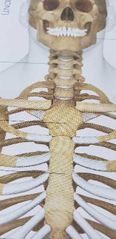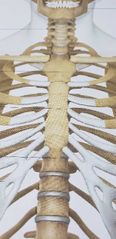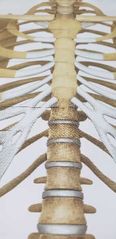![]()
![]()
![]()
Use LEFT and RIGHT arrow keys to navigate between flashcards;
Use UP and DOWN arrow keys to flip the card;
H to show hint;
A reads text to speech;
26 Cards in this Set
- Front
- Back
|
Cranium |
Top of skull that protects the brain and sense organs |
|
|
Mandible |
The jaw, provides attachment for the chewing muscles |
|
|
Clavicle |
Traces a sinuous curve at the base of the neck; it acts as a strut supporting the shoulder |
|
|
Scapula |
Connects the arm to the trunk, and provides a secure but mobile anchor for the arm, allowing the shoulder to be retracted backward, protracted forward, and elevated |
|
|
Humerus |
Arm bone |
|
|
Ulna |
Medual forearm bone. Wide at its proximal end, where it articulates with the humerus at the elbow, this bone tapers to a pointed styloid process near the wrist |
|
|
Radius |
Forearm bone , it can radiate around the ulna to change the orientation of the hand |
|
|
Carpals |
8 small bones in the wrist |
|
|
Metacarples |
5 slender bones hidden at the base of the thumb and palm of the hand |
|
|
Phalanges |
Fourteen bones on each hand, two from the thumb and 3 (proximal, middle, distal) in each hand. |
|
|
Femur |
Largest bone in the body, leg bone |
|
|
Tibia |
Shinbone |
|
|
Fibula |
Attached to the tibia, it contributes to the ankle joint and provides a surface for muscle attachment |
|
|
Tarsals |
A group of 7 bones that form the ankle and heel bone (calcaneus) |
|
|
Metatarsals |
Five bones in the foot equivalent to the metacarpals in the hand |
|
|
Phalanges (foot) |
Fourteen bones that form the phalanges in the foot |
|
|
Patella |
Knee cap |
|
|
Sacrum |
Five fused vertebrae that provides a strong connection between the pelvis and spine |
|
|
Pelvis |
Big oddly shaped hip bone |
|
|
Ribs |
Twelve pairs of bones form the hips |
|
|
Costal cartilages |
Attach the upper ribs to the sternum, and the lower ribs to each other, and give the ribcage flexibility |
|
|
Sternum |
Breastbone containing 3 sections: Manubrium (superior sternum), Gladioulus (middle sternum), and Xyphoid Process (small bone that anchors the sternum) |
|
|
Manubrium |

Upper sternum bone |
|
|
Gladiolus |

Middle sternum bone |
|
|
Xiphoid Process |

Small anchor bone at the base of the sternum |
|
|
Vertebral Column |
Comprised of stacked vertebrae and forms a strong flexible backbone for the skeleton |

